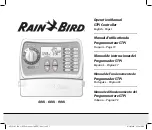
ZIP WATER PURIFIER USER GUIDE
OPERATING CONDITIONS
Do not use water above 104°F (40 °C)
The ambient temperature must be between 40 and 114 °F (4 and 45 °C. )
Keep the system away from extreme temperatures, like cooking surfaces, direct sunlight, and ex-
treme environmental conditions.
Avoid external liquids dripping on the purifier.
CAUTIONS
Do not use with water that is microbiologically unsafe, of unknown quality, or without adequate disin-
fection before or after the system. If the water being used is from a public supply, it will comply with
requirements for water to be used for the Zip purifier and your Zip will substantially improve the water
quality.
In the event that the water to be treated is not from a public water supply, or is of unknown origin, in
order to ensure proper purification, contact your distributor to advise you on the most appropriate
physical, chemical and bacteriological water treatment to use with your Zip system.
Unplug the unit before repair, inspection or filter replacement.
EFFECT OF TDS CONCENTRATION IN THE INLET WATER
Production rate will vary depending on the TDS content (Total Dissolved Solids) and the temperature
of water to be treated. Water with a lower temperature and higher TDS will be filtered more slowly
than water which is warmer or of a lower TDS.
It is recommended to use water with a maximum hardness of 25 grains in order to obtain optimum
performance.
If the inlet water is of hardness greater than 25 grains, or contains high concentrations of iron or
manganese, or hyper chlorination, there may be a reduction in membrane life and performance of
certain components of the purifier.
Zip is designed for TDS up to 800 ppm. For TDS above 800 ppm, consult your dealer. (If the water
being used is from a public supply, it will comply with requirements for water to be used for the Zip
purifier).
Page 6

































